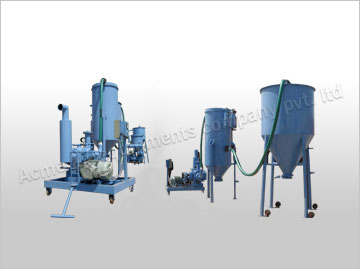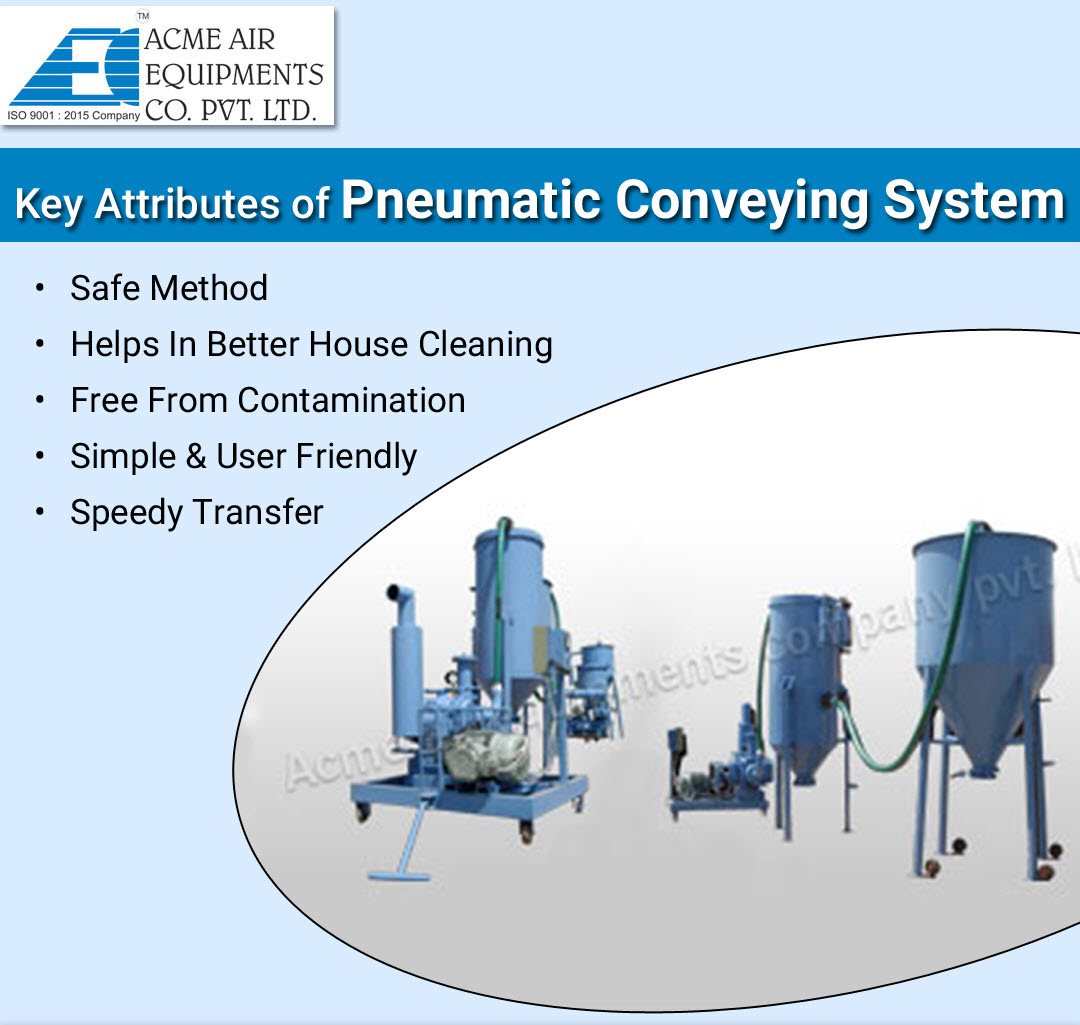Table of Contents
A pneumatic conveying system is designed to move materials from one location to another by means of air pressure. Pneumatic conveying is a relatively easy process. However, it requires trials to generate data necessary for design. Characteristics are provided for several materials and are based on the relationship between the major conveying parameters. This article will help determine about the pneumatic conveying system.
Advantages of Pneumatic Conveying Systems
- Pneumatic conveying systems are a popular choice for industrial facilities and processes. They offer improved safety and overall product quality and are often more efficient than manual methods. These systems work by using pressure differences in an enclosed pipe to move a wide variety of products, including bulk materials, food, and pharmaceutical products. These systems can be used to transport materials over long distances and are also suitable for industries where dust pollution is an issue.
- Pneumatic conveying systems use small diameter pipes and are highly flexible. They can route around existing machinery, reducing space requirements. In addition, they do not have many moving parts, meaning they can be operated more easily and efficiently. Pneumatic conveying systems are also more energy efficient than mechanical systems.
- Another advantage of pneumatic conveying systems is that they are easy to install and maintain. Pneumatic systems use smaller diameter pipelines that are easy to configure. This ensures that the system can be easily adapted to any type of existing equipment. They can also be fitted around existing pieces of equipment, reducing the amount of space needed for installation.
- Pneumatic conveying systems is that they do not require as much space as mechanical systems, making them an attractive choice for companies that need to move large quantities of materials.
- Pneumatic conveying systems are especially useful for industries that require the fast, clean, and precise transfer of dry bulk materials. Pneumatic conveying systems are also a good choice for companies that need to ensure product purity. They can guarantee a consistent rate of transfer while avoiding the mixing of different grain sizes. Additionally, pneumatic conveying systems are free of static electricity, which means they are safer than other methods of conveying.
- Pneumatic conveying systems can move bulk materials between process units. They can be classified into two categories: dense-phase and dilute-phase systems. They have been developed to meet the needs of different industries. For instance, a dense-phase system is preferred for materials that degrade or are highly abrasive.
- The advantage of pneumatic conveying systems over mechanical conveying systems is that they are cost-effective and require less maintenance. Additionally, they are ideal for a variety of materials, including bulk powders and dry materials.
- Another benefit of pneumatic conveying systems is their versatility. These systems are flexible and easy to install. They can be tailored to meet specific needs of a plant and increase its efficiency. However, they can also be costly to install and maintain. Therefore, it is important to understand how pneumatic conveying systems work and how to determine which ones are right for your company.

Requirements for Efficient Power Consumption in Pneumatic Conveying Systems
Power consumption is a major consideration in pneumatic conveying systems. The total pressure drop, the flow rate of solids, and the pipe diameter all influence power consumption. Depending on these factors, different types of pneumatic systems have different power requirements. The pipe bore and routing are also important factors. Finally, the choice of air mover can have a significant effect on the power consumption.
Optimum design is essential to maximizing the efficiency of a pneumatic conveying system. Poor design can cause significant energy loss. However, a properly designed pneumatic system can be more efficient than mechanical systems. Here are some tips to optimize your pneumatic conveying system to reduce energy usage:
- The speed of the bulk solids feeder should match the flow rate of the solids being conveyed. Too fast or too slow of a speed will lead to pressure drops and waste of energy. Oversizing components in pneumatic conveying systems is also a common mistake, which can result in unnecessary energy consumption. For example, if a cylinder is too large, then the system will need more air.
- Pneumatic conveying systems with inadequate air flow rates have problems with pressure loss, resulting in inefficient energy consumption. They also struggle to convey materials and could even cause blockages, which can halt production and lead to higher energy costs. The solution to this problem is to properly feed the material. Otherwise, air leaks can cause pressure drops.
- Pneumatic conveying systems are also quieter than mechanical systems. This means that they require less maintenance. They are also more flexible. Pneumatic conveying systems can transport materials over a large distance and multiple elevations. Additionally, they are easy to add new destinations. These advantages make pneumatic conveying a more economical option for your materials handling needs.
- Pneumatic conveying systems can run under pressure or under vacuum. The choice depends on the type of material. Some materials are more difficult to convey with pneumatic systems, such as those with large particle size or bulk density. Sticky materials can also clog up the system. These materials may require mechanical conveying systems. There are two main types of pneumatic conveying systems. The first type runs under pressure and the second runs under vacuum.
- One of the most important factors that affect power consumption is the speed of the conveying gas. By using a rotary airlock valve, pneumatic conveying systems can operate in either a dense or dilute phase. They also have different solids loading ratios. The lower the Froude number, the lower the specific power consumption.

Cost of Modifying a Pneumatic Conveying System
Modifying a pneumatic conveying system requires some planning. This process involves collecting information about the material to be conveyed, the feed and gas rates, and the layout of the equipment. It also involves troubleshooting issues that can occur. Pneumatic conveying systems are best suited for smaller volumes of material but can be adapted for larger volumes.
Before beginning the process, the manufacturer of the pneumatic conveying system must know exactly what type of material it is conveying. The type of container will dictate the type of pickup point, which can include a wand, bagging station, bulk bag unloader, docking station, pick-up adapter, and more. This pickup point is one of the most customized parts of the pneumatic conveying system and is critical to feeding the material into the system.
Modifying a pneumatic conveying system can be an expensive and difficult process, but it can be done. It is important to understand the air pressure and flow requirements, since if you do not, it can reduce the capacity of the system. If you don’t know the exact airflow and pressure requirements of your system, you may need to test the material to determine whether it is resistant or not.
If you need to change the process, you may need to modify the conveying system. This may be required when you need to add capacity or change other aspects of the process. You may also need to reroute a conveying line. You must be aware of the risks associated with this process when modifying a pneumatic conveying system. When modifying a pneumatic conveying system, you must consider the material to be conveyed. Then, you must determine what rate and amount of air is required. You need to determine how much material attrition is acceptable and verify this.
The Bottom Line
Pneumatic conveying systems have several advantages over mechanical systems. They are more environmentally friendly, have a lower cost of operation, and can be easily modified and customized. This system allows you to reduce the amount of energy used and keeps your materials clean. A pneumatic conveying system also has the potential to make materials safe for the environment.
Pneumatic conveying systems are used for dry bulk material transportation. This process involves air flow through an enclosed pipeline. The air flows through a system that is attached to a compressor. This air provides the necessary pressure to move the materials over certain distances. This system also has the benefit of being flexible and reroutable.



